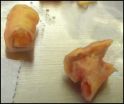(Press-News.org) Chastity belts were not first thought out in mediaeval times – members of many animal groups have evolved similar mechanical safeguards to ensure their paternity. Male dwarf spiders, for instance, use mating plugs to block off the genital tract of the female they have just mated with. The larger and older the plug, the better the chances are that other males will not make deposits in a female's sperm storage organ, too. So says Katrin Kunz and co-authors of the Zoological Institute and Museum in Greifswald, Germany, in an article published in Springer's journal Behavioral Ecology and Sociobiology about this European spider.
This study builds on previous research led by co-author Gabriele Uhl that showed that dwarf spider males (Oedothorax retusus) insert mating plugs into the two copulatory ducts of the females they have mated with.
Kunz and her colleagues took these findings one step further to study just how well the mating plugs of the dwarf spider work. They discovered that the material the plugs are made of is transferred in a liquid state from the male to the female and that it needs to harden to a certain degree before it can withstand penetration or removal by a rival male. Remating trials were then staged after females received plugs of different sizes during a first round of copulation. Their effectiveness over periods of time was also tested. The female spiders were then scrutinized under a scanning electron microscope.
Overall, small plugs were found to be less effective than large plugs. This suggests that smaller portions of the translucent plug material can be more easily removed or overcome by a subsequent male that wants to mate. Small plugs are also least effective shortly after they are placed, which suggests that both size and the hardening of the material plays an important role in how well the plug works. Once plugs are older than a day they strongly serve to monopolize access to the duct that leads to the female sperm storage organ.
However, even if subsequent males are able to mate, at least part of their sperm mass remains outside of the female genital tract, confirming the efficacy of the mating plug. Consequently, if a male succeeds in plugging both of the female's copulatory openings, his paternity success is expected to be very high.
"The mating plug in the dwarf spider clearly functions as a mechanical obstacle to rival males," says Kunz. "Mating plugs are a powerful mechanical safeguard whose efficacy varies with plug size and age."
INFORMATION:
Reference: Kunz, K. et al (2014). Does the size and age of mating plugs alter their efficacy in protecting paternity? Behavioral Ecology and Sociobiology, DOI 10.1007/s00265-014-1742-7
The full-text article, photos, and a video are available to journalists on request.
Male dwarf spiders make sure offspring is their own
Mating plug prevents other male spiders from depositing sperm
2014-06-10
ELSE PRESS RELEASES FROM THIS DATE:
Signpost for health services: Teenagers go from school psychologist to family doctor
2014-06-10
After initially visiting a school psychologist, adolescents in the United States with a mental disorder often go to seek care from their pediatricians or family doctors. Fewer of them continue their treatment directly with a psychotherapist or doctor specialized in mental disorders. This shows an analysis conducted by scientists at the University of Basel that has just been published in the academic journal PLOS ONE. The results are based on a nationally representative cohort of 6,500 U.S. teenagers.
A considerable number of children and adolescents suffer from a mental ...
ESMO survey sheds light on common clinical practice for incompletely resected lung cancer
2014-06-10
VIDEO:
R.Califano explains why ESMO Young Oncologists launched a survey on common clinical practice for incompletely resected lung cancer and analyses interesting results claiming for more adherence to guidelines and more...
Click here for more information.
Lugano, Switzerland, 10 June 2014 -- A landmark survey of more than 700 specialists provides crucial real-world insight into the treatments most oncologists choose for lung cancer patients whose tumour has been incompletely ...
Game changer for leukemia therapy
2014-06-10
Australian researchers are zeroing in on a promising new approach to killing off cancer cells in patients with leukemia.
In a study led by the South Australian Health and Medical Research Institute (SAHMRI) and the University of Adelaide's Centre for Personalised Cancer Medicine, researchers have found that cancer cells decide whether to live or die after a short period of intense exposure to targeted therapy, opposing the current requirement for continuous treatment.
The researchers say this study presents a new treatment strategy which will translate to a significant ...
Women appear in only 5 percent of sports newsprint
2014-06-10
This news release is available in Spanish.
Women are the subject of news in sports papers in only 5.11% of the cases, sometimes alone (2.18%) and others accompanied by men (2.93%). On the other hand, men are the focus of this kind of information in 92.2% of the cases, according to a study presented recently by UC3M professor Clara Sainz de Baranda at the II International Conference on Gender and Communication. "The remaining 5% is neutral information, which is why, in these kinds of topics, like soccer balls, fields, field houses and goals, men appear more often ...
New teaching approach touted for engineering education
2014-06-10
WEST LAFAYETTE, Ind. – Purdue University researchers who developed a new approach to more effectively teach large numbers of engineering students are recommending that the approach be considered for adoption by universities globally.
The system, called the Purdue Mechanics Freeform Classroom, allows students to interact with each other and faculty online while accessing hundreds of instructional videos and animations. It was pioneered by Charles Krousgrill, a professor of mechanical engineering, and has been used for more than two years in two mechanical engineering core ...
Virginia Tech architect reveals 'green roofs' need not go to great depths to work
2014-06-10
Hot town, summer in the city — it's nothing new, but ways to handle the heat, humidity, and stormwater haven't changed much since the invention of the sewer system.
One solution offered by architectural researchers is known as a "green roof" — a roof covered in living, growing plants to soften the effects of heat, flooding, noise, and stormwater runoff.
Elizabeth J. Grant, an assistant professor of architecture and design at Virginia Tech, will present ways for architects to determine the most effective depths of green roofing for stormwater control on Thursday at the ...
Scientific breakthrough: International collaboration has sequence salmon genome
2014-06-10
Vancouver, BC - Today the International Cooperation to Sequence the Atlantic Salmon Genome (ICSASG) announced completion of a fully mapped and openly accessible salmon genome. This reference genome will provide crucial information to fish managers to improve the production and sustainability of aquaculture operations, and address challenges around conservation of wild stocks, preservation of at-risk fish populations and environmental sustainability. This breakthrough was announced at the International Conference on Integrative Salmonid Biology (ICISB) being held in Vancouver ...
MRI shows brain abnormalities in late preterm infants
2014-06-10
OAK BROOK, Ill. – Babies born 32 to 36 weeks into gestation may have smaller brains and other brain abnormalities that could lead to long-term developmental problems, according to a new study published online in the journal Radiology.
Much of the existing knowledge on preterm birth and brain development has been drawn from studies of individuals born very preterm, or less than 32 weeks into gestation at birth.
For the new study, researchers in Australia focused on moderate and late preterm (MLPT) babies —those born between 32 weeks, zero days, and 36 weeks, six days, ...
Bacteria help explain why stress, fear trigger heart attacks
2014-06-10
WASHINGTON, DC – June 10, 2014 - Scientists believe they have an explanation for the axiom that stress, emotional shock, or overexertion may trigger heart attacks in vulnerable people. Hormones released during these events appear to cause bacterial biofilms on arterial walls to disperse, allowing plaque deposits to rupture into the bloodstream, according to research published in published today in mBio®, the online open-access journal of the American Society for Microbiology.
"Our hypothesis fitted with the observation that heart attack and stroke often occur following ...
Fox Chase doctors urge caution over new analysis of Medicare payments
2014-06-10
PHILADELPHIA, PA (June 9, 2014)—There's much to learn from the recent release of unprecedented amounts of data from the nation's second largest health insurer, Medicare, but only if interpreted cautiously, write two doctors at Fox Chase Cancer Center in the June 9 online edition of the Annals of Internal Medicine.
In April, the Centers for Medicare and Medicaid Services (CMS) released the most detailed data in its history, related to $77 billion worth of physician billings to Medicare. In its analysis of the data, The New York Times showed that only a small percentage ...
LAST 30 PRESS RELEASES:
Sophisticated neuroimaging reveals PTSD in WTC responders is linked to measurable physical changes in brain structure
Health policy experts identify promising strategies for providing health care to homeless people
Study explores role of neutrophils in canine atopic dermatitis
Mayo Clinic researchers develop AI-ECG model to diagnose liver disease earlier
Heavy menstruation common among teenage girls – questionnaire reveals risk of iron deficiency
New study explores why open water swimming feels so powerful for midlife women
In echo of Jurassic Park, mosquitoes capture entire ecosystems in their blood meals
Marty Cooper, Illinois Tech Alumnus and ‘Father of the Cell Phone,’ Receives 2025 Marconi Society Lifetime Achievement Award
How to reduce the risk of lymphedema
NEJM Evidence and CIDRAP announce Public Health Alerts
New fossil study illuminates on the evolutionary success of frogs
Patient-specific human liver model to understand disease mechanisms
Confused by the doctor's questionnaire? U of A study suggests it's common
How do brains stay stable, and when might a dose of flexibility be helpful?
mRNA revitalizes aging immune systems—the liver as a fountain of youth
Rural-urban differences in the prevalence of chronic pain among adult cancer survivors
Food insecurity, burnout, and social isolation among resident and fellow physicians
How do spinal cord injuries heal?
Detailed cell map unlocks secrets of how reproductive organs form
Large language models unleash AI’s potential for autonomous and explainable materials discovery
Gut bacteria have evolved rapidly to digest starches in ultra-processed foods
New risk score helps predict pancreatic cancer recurrence
New evidence challenges understanding of Parkinson’s disease
A new study reveals how embryos and the uterus “talk” during implantation
Cedars-Sinai reports heart attacks, general illness spiked after LA fires
PolyU develops ultra-stable, mucus-inspired hydrogel to boost gastrointestinal wound healing
Flour choice shapes sourdough microbial communities
Can a retinal implant reverse macular degeneration?
Feeding fungi plant remnants produces tasty protein to fortify vegan, vegetarian diets
New tech reduces false positives from breast ultrasounds
[Press-News.org] Male dwarf spiders make sure offspring is their ownMating plug prevents other male spiders from depositing sperm





